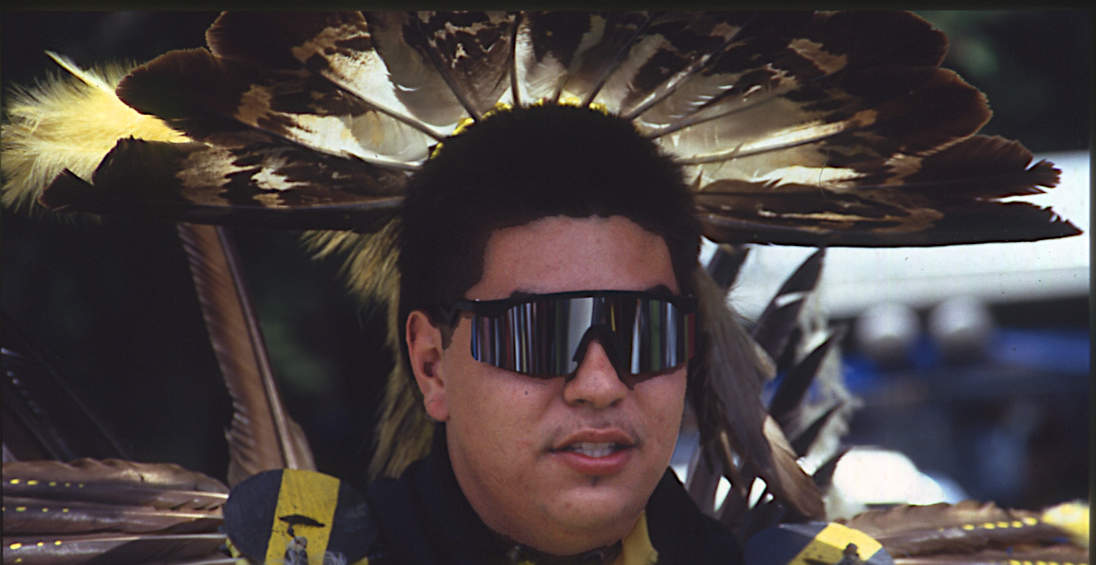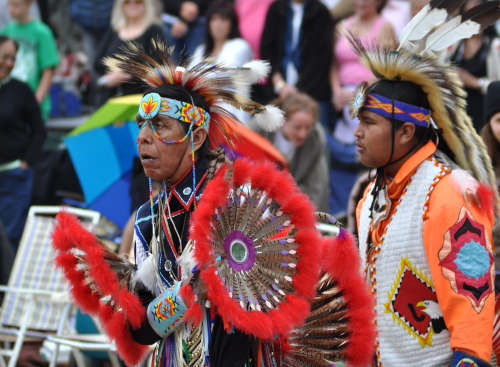
America's Indian heritage
The historic culture of Native Americans
- Main
menu ►
- Life and
institutions
- Tourism & travel
- Places
►
You are here : About-the-USA.com
› Native American heritage
About-the-USA.com
A guide to discovering the United States
A guide to discovering the United States
| Index : | Buildings and places | Art | Traditions |
Terminology.
Indians? Indian-Americans? Native Americans? Which is the
correct term
to use? Answer: they can all be correct, as long as they are used with
respect. Most tribes or nations prefer to be known by their
tribal name, Cherokees, Sioux or whatever is appropriate; but
collectively most are happy with the term Indian. Before the new museum
of
the American Indian opened in Washington in 2004, project directors
consulted
nationally with tribes from all over the USA. The term eventually
chosen, with general approval, was "American Indian".
For centuries before Christopher Columbus "discovered" America, the "New World" was home to millions of humans. Central and South America even had great civilizations, the best documented being the Aztecs and the Incas, whose impressive stone monuments are major heritage sites.
In the area now known as the USA, only a minority of of people in pre-Columbian era lived in fixed stone dwellings; most were either nomadic, living in teepees or other mobile structures, or lived in wooden buildings or earth-lodges, few of which have survived to this day. Consequently Indian heritage in the USA today is less in the form of buildings, than in places, arts and crafts and traditions.

Mesa Verde -
Colorado
Indian heritage buildings
Most of the historic pre-Colombian buildings standing today in the USA are the remains of villages built by the Pueblo people between the seventh and fourteenth centuries, and abandoned well before the arrival of Europeans.Living in a dry part of the continent that is now Colorado, New Mexico and Arizona, the Pueblo people built permanent settlements using stone and adobe. The most famous of these is the stone village built into a cliff at Mesa Verde, Colorado, which is now a National Park and UNESCO World Heritage Site.
The Mesa Verde National Park area contains several more historic stone dwellings. Other historic pueblo buildings can be found in New Mexico, Arizona and southern Utah.
Some of today's descendants of the Pueblo people, the Hopis or the Acomas, still live in and maintain the sites of historic pueblos. One particularly interesting historic site is Acoma Pueblo in New Mexico, whose oldest buildings were put up in the eleventh century, making it one of the oldest continually occupied sites in the USA. The village was first described by a Spanish soldier in 1540 (that's 80 years before the establishment of the first successful north American colony by the English, in 1620). Perched on the flat top of a rock mesa (table), this is no theme park; it is a living village of adobe-brick buildings with some thirty permanent residents. The site has a museum and cultural center, and can be visited in the summer months. Website
Other places and museums
There are a number of Stonehenges in the USA, but they are all fake. However there are also quite a few genuine stone circles, less impressive to be sure, but historic in the same way. The most interesting of these is the Medicine Wheel at the treeless summit of Medicine Mountain in Big Horn National Forest, Wyoming. It is an alignment of stones on the ground in the shape of a wheel with spokes, 24 metres in diameter. It is reached at the end of a 2 km trail, and is well worth the hike.Another interesting site, recently given UNESCO World Heritage status, is the Hopewell Culture National Historical Park, in Ohio - a network of mounds and earthworks at least a thousand years old.
In more northern parts of the USA, and in the centuries before Europeans arrived in North America, many native tribes were sedentary, or part sedentary, building semi-permanent communal dwellings known today as long houses. These were built using saplings (the thin trunks of young trees), skins, twigs and other organic materials, and fell rapidly into decay once abandoned. No historic examples survive, but modern reproductions have been made in a number of historic parks, including at Lancaster, Pennsylvania, and at the The Museum of Ojibwa Culture in Saint Ignace , Michigan.
The Ojibwa museum is one of many Indian or Native American museums across the USA. These include the two sites of the National Museum of the American Indian, the main one in Washington D.C, the other in New York, both containing huge collections of items and displays representing Indian culture and history throughout the USA. Elsewhere, many other museums tell the story of local tribes and nations. Among the more interesting of these are the Navajo Nation Museum at Window Rock, Arizona, the Iroquois Museum at Howes Cave near Albany in the state of New York, or the large First Americans Museum in Oklahoma city, with its multimedia exhibits telling the story of the 39 tribes living in this part of the USA.
One final site than cannot go unmentioned here is the giant statue of Indian chief Crazy Horse that is being hewn out of the mountainside in the Black Hills of South Dakota. Begun in 1948 by sculptor Korczak Ziolkowski, who had previously worked on the nearby giant statues at Mount Rushmore, the giant statue is still unfininshed but the project is being carried on by his children and grandchildren. When complete, it will be the second biggest statue in the world. The Crazy Horse memorial is already a major visitor attraction, and the site is home to a number of exhibits, including the Indian Museum of North America.
Native American art

The great
Hunt panel in Ninemile Canyon
The finest examples of historic Indian art is to be found at the Petroglyph National Monument, on the outskirts of Albuquerque, New Mexico, where most of the thousands of images are at least 400 years old.
Another exceptionally interesting petroglyph site is Ninemile Canyon, near Price, Utah. It runs between Wellington on US Highway 6 and Myton on Highway 40 - meaning that it's rather out of the way; but the 46 miles (not 9) of the Canyon are paved and waymarked. There are numerous historic petroglyph and rock art sites, some beside the road, others a short walk away, others high up on rock ledges. There's a map available on the the BLM (US Bureau of Land Management) website.
Contemporary native arts and crafts are popular, and can be bought at visitor centers, stores and trading posts at or near many Indian reservations. Buying arts and crafts locally usually means getting the genuine product; for although the Indian Arts and Crafts Act (Act) of 1990 made it a criminal offense in the United States to sell anything labeled" Native American Art", unless it is genuine, there are plenty of fake native American souvenirs available in other places and online. Among the more popular items available in Indian outlets are dream-catchers, pottery and hand-made jewellery.
Traditions and events

Traditional
costumes and dances on display at a powwow
Most pow-wows are open to the public, and visitors are more than welcome. Anyone wanting to attend a pow-wow can check up dates online on the national calendar of events at powwows.com . Some are indoors, but most – specially during the warm seasons – are outdoors, providing a marvellous day out or afternoon in contact with the living traditions of American Indians.
Apart from powows, Indian events in the USA and Canada also include Indian Rodeos, rodeos open only or mainly to native Ameican riders. Native American horsemen have been involved in the herding and moving of cattle across the North American continent since the sixteenth century, along with white vaqueros or cowboys, and have long been reputed for their equestrian skills. Like pow-wows, rodeos are one-off events, and visitors need to check out what is happening locally. One predictable annual event is the Indian National Finals Rodeo, held each year in October in Las Vegas.
For more background to the USA.....
► Book / ebook A Background to modern America - people, places and events that have played a significant role in the shaping of modern America. A C1-level Advanced English reader for speakers of other languages, and anyone wanting to learn some of the background to today's USA. Twenty-two texts, with vocabulary guides and exercises. Linguapress 2023.For California, discover About-California.com, a short guide for visitors.
About-the-usa.com
Home
page
Other
places, other countries...
Partner websites
Institutions, life and tourism- About France - a thematic guide to France. Over 200 pages of information for visitors and students.
- About Britain - a thematic introduction to Britain covering institutions, life and tourism
- Angleterre.org.uk - Le guide de l'Angleterre, en français
Travel and tourism
- About Quebec - Discover the French-speaking province of Canada
- About California - a thematic travel guide to California
- About-Portugal.com - Discover Portugal and its regions
- About Spain - discover the real Spain - an incomplete guide to Spain on and off the beaten track
Text © About-the-usa.com
About : About-the-usa.com is a Travel-Webs site
To contact this website please use the form provided.
Photo credits.
Top of page © Andrew Rossiter / About-the-USA.com
Mesa Verde photo by Wallace Bennett
Pow-wow photo by Steve Mabel, licence Creative Commons 2.0.

